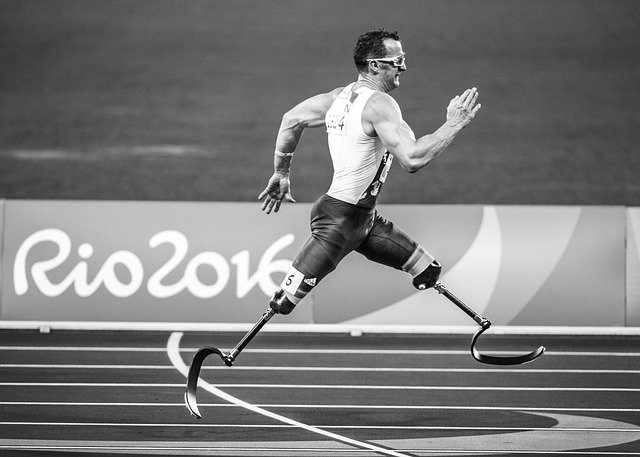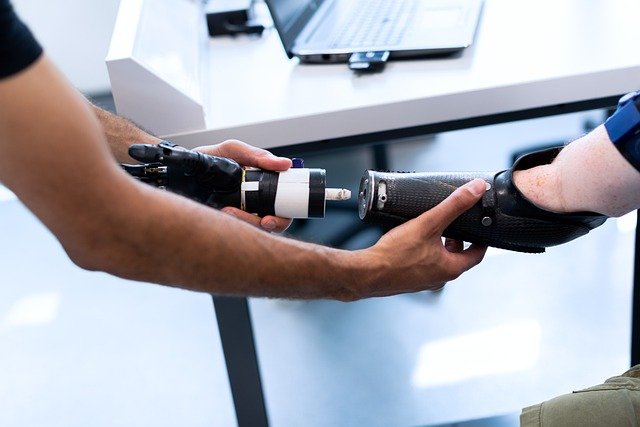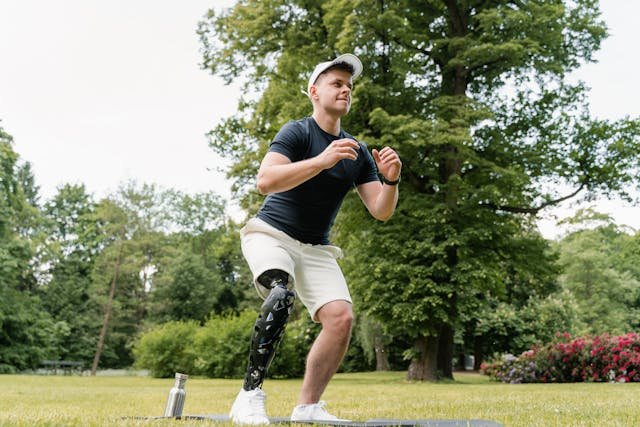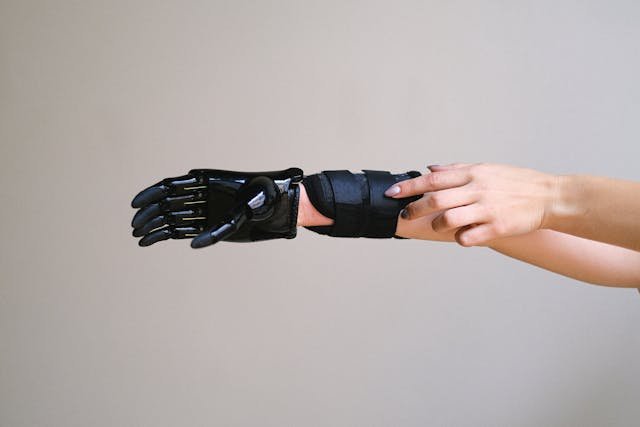Prosthetic technology has come a long way, but one of the biggest factors influencing comfort, function, and longevity is the materials used in their construction. Prosthetic limbs must be lightweight yet strong, flexible yet durable, and comfortable for daily use. Until now, many prosthetics have relied on traditional metals, plastics, and silicone, but the future is set to bring a new wave of advanced materials that will make artificial limbs more resilient, adaptable, and natural-feeling.
Over the next five years, research in nanotechnology, smart polymers, and bioengineered materials will reshape prosthetic design. These innovations will help create stronger, more flexible, and longer-lasting prosthetic limbs that adapt to each user’s lifestyle. At Robobionics, we are committed to integrating cutting-edge materials into our prosthetic solutions, ensuring that users experience unparalleled comfort, performance, and durability.
In this article, we explore the latest breakthroughs in prosthetic materials and how they will shape the future of artificial limbs by 2030.
1. The Shift Toward Carbon Fiber and Graphene: Strength Without Weight
For years, carbon fiber has been a preferred material for prosthetic limbs because of its lightweight structure and high durability. However, the next evolution in prosthetic materials is graphene-infused carbon fiber, which offers even greater strength, flexibility, and wear resistance.
Graphene is 200 times stronger than steel while remaining ultra-light, making it an ideal reinforcement material for prosthetics. By integrating graphene into carbon fiber structures, prosthetic limbs can become stronger, thinner, and more impact-resistant. This means users can enjoy greater freedom of movement without worrying about material fatigue or structural breakdown.
By 2030, we can expect graphene-based prosthetics to be widely available, offering users increased durability and a more natural range of motion. These materials will also make high-performance prosthetics more affordable and accessible, allowing athletes, active users, and everyday wearers to experience unmatched durability without added weight.
2. Smart Polymers: Materials That Adjust to Movement

Traditional prosthetics often feel stiff and unnatural, especially during high-impact activities like running or climbing. Smart polymers are set to change that by introducing flexible, self-adjusting materials that respond to movement in real-time.
These shape-memory polymers can soften or stiffen based on temperature, pressure, or muscle signals. For example, a prosthetic foot made with smart polymer layers could provide firm support while walking on solid ground but soften when stepping on uneven terrain, reducing impact stress on the body.
By 2030, prosthetics using AI-driven smart polymers will allow real-time adjustments, providing customized stiffness, shock absorption, and flexibility based on the user’s movement patterns. This technology will make prosthetics more adaptable, reducing strain and improving comfort for users of all activity levels.
3. Bioengineered Skin for a More Natural Feel
One of the biggest challenges in prosthetic development has been replicating the look and feel of natural skin. Traditional prosthetic covers often lack texture, elasticity, and temperature regulation, making them feel unnatural to the touch. But with advances in bioengineered materials, prosthetic skin is about to become more realistic, flexible, and even self-healing.
Researchers are developing synthetic skin layers infused with nanotechnology, which mimic human skin elasticity, texture, and temperature sensitivity. These materials will not only look and feel more natural but will also integrate with haptic feedback systems, allowing users to experience touch and pressure sensations through their artificial limbs.
By 2030, prosthetic skin materials will feature self-healing properties, meaning minor scratches or tears can repair themselves, extending the lifespan of prosthetic covers. This will help users experience aesthetic and functional improvements, making prosthetics feel like a natural part of the body.
4. Titanium and Advanced Metal Alloys: Unbreakable Yet Lightweight

Titanium has long been used in prosthetic limbs due to its high strength-to-weight ratio and corrosion resistance, but researchers are now enhancing titanium with next-generation alloys that make it even stronger, lighter, and more flexible.
Future prosthetic frames will incorporate titanium-aluminum-vanadium blends, which provide better impact absorption, lower weight, and increased durability. This means prosthetic users can engage in more high-impact activities without worrying about metal fatigue or failure.
By 2030, titanium-based prosthetic components will also integrate nano-coatings that resist bacteria growth, helping to reduce skin irritation and infection risks. These advancements will make prosthetic limbs stronger, cleaner, and longer-lasting for users worldwide.
5. 3D-Printed Composite Materials: Personalized, Durable, and Cost-Effective
3D printing is revolutionizing custom prosthetic design, and with the introduction of new composite materials, prosthetics are becoming stronger, more precise, and more affordable.
Future 3D-printed prosthetics will use composite resins mixed with carbon fibers, kevlar, and thermoplastics, creating ultra-durable yet flexible structures. These materials will allow for faster production of custom-fit prosthetics, ensuring that each limb is tailored to the user’s exact dimensions and movement needs.
By 2030, fully 3D-printed prosthetic limbs will be as strong as traditionally manufactured ones, offering users a more affordable and accessible option without compromising durability or performance.
6. Waterproof and Weather-Resistant Coatings for Extreme Conditions

Prosthetic users often worry about water damage, extreme temperatures, and material wear over time. To address this, researchers are developing next-generation waterproof and climate-resistant coatings that will make prosthetic limbs fully weatherproof.
Future prosthetic materials will include hydrophobic nano-coatings that repel water, dust, and sweat, ensuring better long-term durability. Additionally, temperature-sensitive layers will help regulate surface temperature, preventing overheating in the summer or extreme cold in the winter.
By 2030, prosthetic users will no longer have to worry about rain, snow, or heat affecting their artificial limbs, making everyday mobility more seamless and worry-free.
7. Self-Healing Materials: Extending Prosthetic Lifespan
One of the biggest concerns for prosthetic users is wear and tear. Over time, constant use leads to scratches, micro-cracks, and material fatigue, reducing the lifespan of prosthetic limbs. But the next generation of prosthetic materials will include self-healing polymers and composites, which can repair minor damage on their own without requiring frequent replacements.
Self-healing materials use embedded microcapsules filled with a healing agent that is released when a crack or scratch occurs. This allows the material to “heal” itself, restoring its original strength and structure. Researchers are also developing biological-inspired materials, similar to human skin, that can regenerate damaged areas using heat or light exposure.
By 2030, prosthetics made from self-repairing materials will significantly reduce maintenance costs, increase longevity, and enhance user confidence. This technology will ensure that minor damage does not compromise performance, making artificial limbs more resilient for everyday and extreme conditions.
8. Bacterial-Resistant Materials for Healthier Prosthetics

For prosthetic users, hygiene is crucial, especially for socket liners and contact surfaces that are in direct contact with the skin. Bacteria buildup can cause skin irritation, infections, and unpleasant odors, making it uncomfortable to wear a prosthetic for extended periods.
To solve this, researchers are developing bacterial-resistant materials that prevent microbial growth. These materials use silver nanoparticles, graphene coatings, and antimicrobial polymers to create self-cleaning surfaces that reduce bacterial buildup and skin irritation.
By 2030, prosthetic users will benefit from hygienic, odor-free, and infection-resistant materials, making daily use safer, more comfortable, and low-maintenance. This will be especially beneficial for amputees in hot or humid climates, where sweat and moisture buildup can increase the risk of skin infections.
9. Ultra-Flexible Gel-Based Liners for Superior Comfort
A prosthetic’s fit and comfort depend largely on its socket liner, the part that connects the prosthetic to the user’s residual limb. Many current liners are made from silicone or rubber-like materials, but they often lack flexibility, cause pressure points, or trap heat, leading to discomfort.
Future prosthetic liners will use ultra-flexible gel-based materials, which mold perfectly to the user’s limb shape, providing a cushioned, breathable, and pressure-free fit. These materials will also include temperature-regulating properties, ensuring that users remain cool in the summer and warm in the winter.
By 2030, gel-based liners will feature smart cushioning technology, adjusting stiffness or softness based on the user’s movement and weight distribution. This will eliminate friction, reduce skin irritation, and improve long-term comfort, allowing users to wear prosthetics for longer periods without discomfort.
10. High-Performance Shock-Absorbing Materials for Active Users

For athletes, runners, and physically active individuals, prosthetics must withstand impact, absorb shocks, and provide energy return for efficient movement. Traditional prosthetics often rely on carbon fiber springs, but the next generation will introduce high-tech elastomers and energy-absorbing foams for better performance.
These new-generation shock-absorbing materials will adjust to impact forces in real-time, preventing joint strain and reducing overall fatigue. This means that prosthetic runners, basketball players, and rock climbers can move with greater ease, experiencing better responsiveness and lower impact on their joints.
By 2030, these materials will be widely available in both standard and high-performance prosthetics, ensuring that everyone—from casual walkers to elite athletes—benefits from greater comfort and energy efficiency.
11. AI-Integrated Smart Materials for Adaptive Performance
Artificial Intelligence (AI) is changing the way prosthetics function, but by 2030, AI will also influence prosthetic materials. AI-integrated smart materials will allow prosthetics to adapt in real time based on environmental conditions, movement patterns, and user needs.
For example, an AI-driven leg prosthetic could stiffen on rocky terrain and soften on smooth floors, improving comfort and energy use. Similarly, AI-integrated gripping surfaces in bionic hands will adjust grip force based on object texture and weight, preventing accidental drops or excessive pressure.
These innovations will create next-level, fully adaptive prosthetics, making movement more intuitive, precise, and effortless. By 2030, AI-powered prosthetic materials will give users a seamless, natural experience, reducing manual adjustments and making artificial limbs feel like a true extension of the body.
12. Prosthetic Materials for Extreme Environments: From Deep Water to Outer Space

As prosthetic technology advances, users will need materials that can perform in extreme conditions—from deep-sea environments to high-altitude space travel. Future prosthetic materials will be designed to resist extreme pressure, temperature fluctuations, and radiation exposure.
For instance, deep-sea prosthetics will be made from pressure-resistant composites, allowing users to swim and dive without water damage or material degradation. Similarly, prosthetic limbs for astronauts will feature radiation-resistant coatings and zero-gravity adjustments, ensuring comfort and durability even in space.
By 2030, we can expect specialized prosthetics for adventurers, deep-sea divers, and even astronauts, expanding possibilities for amputees in every extreme environment imaginable.
13. The Role of Sustainable and Eco-Friendly Prosthetic Materials
As technology advances, the focus on sustainability is becoming more important. Traditional prosthetic materials, such as plastics and metal alloys, can have a high environmental impact, especially during manufacturing and disposal. The future will bring eco-friendly prosthetic materials that are just as durable and flexible while being better for the planet.
Researchers are developing biodegradable polymers, plant-based resins, and recycled composites that will make prosthetics strong, lightweight, and environmentally responsible. Some materials are even being sourced from waste plastic and carbon-neutral sources, reducing pollution and making prosthetic production more sustainable.
By 2030, eco-friendly prosthetics will be widely available, allowing users to choose limbs that are not only high-performing but also ethically produced. This shift toward green materials will ensure that prosthetic technology evolves without harming the environment, making it a win-win for both users and the planet.
14. Advanced Anti-Fatigue Materials for All-Day Comfort

Many prosthetic users experience residual limb fatigue after long hours of wear. The constant pressure and weight of a prosthetic limb can lead to soreness, irritation, and discomfort, especially for users who are highly active. The next generation of prosthetic materials will focus on reducing user fatigue with advanced shock-absorbing and pressure-distributing properties.
New anti-fatigue materials will be made from flexible microfoam composites that evenly distribute pressure and absorb impact forces while walking or gripping objects. These materials will also be temperature-responsive, ensuring that users stay cool in hot weather and warm in colder climates.
By 2030, prosthetics will be designed with built-in fatigue-reducing materials, allowing users to wear their limbs longer without strain. This will improve daily comfort and energy efficiency, making prosthetics feel more natural and effortless.
15. The Integration of Soft Robotics into Prosthetic Materials
Soft robotics is an exciting field that is changing how prosthetic limbs function and move. Unlike traditional rigid prosthetics, soft robotic materials use flexible, inflatable structures that mimic human muscle movement.
Future prosthetic hands and arms will be made with soft, silicone-based robotic tendons that contract and relax like natural muscles. These soft robotic materials will allow for gentle, lifelike movement, improving grip sensitivity, dexterity, and precision.
By 2030, soft robotic prosthetics will be able to adapt to different movements, providing a smoother, more natural range of motion. This innovation will be especially beneficial for upper-limb amputees, allowing them to perform delicate tasks with greater control and ease.
Final Thoughts: A Future Built on Durability and Flexibility
The next five years will transform the materials used in prosthetic limbs, making them stronger, more flexible, and highly adaptable. From graphene-infused carbon fiber and shape-memory polymers to bioengineered skin and self-healing coatings, these advancements will help prosthetic users experience unmatched durability, comfort, and freedom of movement.
At Robobionics, we are at the forefront of these innovations, integrating the latest material breakthroughs into our prosthetic solutions like Grippy™. Our mission is to ensure that every user experiences the best in comfort, strength, and long-term reliability.
If you’re looking for a cutting-edge prosthetic solution that adapts to your life, book a free demo with Robobionics today and take the first step toward a future of unmatched mobility and durability! Your journey to better prosthetic technology starts now.



